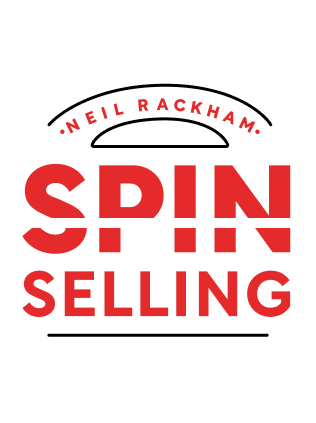

This article is an excerpt from the Shortform summary of "Spin Selling" by Neil Rackham. Shortform has the world's best summaries of books you should be reading.
Like this article? Sign up for a free trial here .
What is a sales framework? Can you learn a sales framework to improve your sales?
A sales framework can help you create a sales strategy and work toward your sales goals. When you apply a sales framework, you gain consistency in your skills and a solid strategy.
The SPIN Sales Framework
A sales framework is necessary to become a good salesperson. The SPIN framework is about asking questions to base your sale on customer needs. The SPIN sales strategy framework is below.
Opening the Call
How you should open a sales call—that is, how to introduce yourself and start the conversation—depends on whether it’s a small sale or large sale. They take different approaches to get the call off on the right foot.
In discussing openings, this chapter focuses on how to approach initial meetings with new customers, as opposed to opening calls in an ongoing sales process.
Most older sales training asserted that first impressions could make or break a new customer interaction. But research indicates first impressions carry less weight than once thought. Of course, a professional overall appearance is important, but small details matter less. The impression you make in the investigating stage is far more crucial to sales success than your initial interaction is.
The reason first interactions matter less than people think is that in the early stages of meeting someone, you’re getting so much information that you immediately forget some things—sometimes even the person’s name.
Certain details, such as dress, may matter more in small sales, but a great outfit and opening line aren’t going to significantly boost your chances of success in a large sale.
An Opening Sales Framework
Instead of traditional methods of call opening, researchers came up with an opening sales framework based on strategies used by successful salespeople.
The first step is understanding your objectives in the warm-up or opening stage of a call. Basically, you want the customer to agree to give you a hearing and answer your questions, so you can move into the investigating stage.
To win consent, you need to specify:
- Who you are
- What you want (without delving into product details)
- Your legitimacy or right to ask questions
Opening Effectively
You’ll need a good opening in your sales strategy framework. As previously noted, openings don’t play a critical role in large sales. You don’t need to come across as polished or rehearsed, but there are three important elements to an effective opening:
1) Get to the point of your visit quickly. Don’t spend too much time on a long wind-up. You don’t want to run out of time in the more important stages because you spent time making a lot of small talk at the beginning. You also don’t want to waste your customer’s time. In large sales, you’re not likely to offend busy customers by jumping into your topic with few preliminaries.
2) Don’t talk about solutions prematurely. As noted in the previous chapter, talking about solutions too soon can trigger objections and undermine your success. Discussing your solution early in the call also puts you in the position of answering questions about your product or services, when you need to quickly assume the role of questioner so you can develop needs.
3) Focus on asking questions. Remember that the opening isn’t the important part of the call; you want to move on to the investigating stage as soon as possible. Instead of worrying about how to open a call, spend your pre-call planning time working on questions to uncover and build needs.
Four Steps for Implementing a SPIN Sales Framework
Here are four steps for translating the SPIN ideas and techniques into your sales framework.
1) Focus Your Planning on the Investigating Stage
When sales reps plan calls, they tend to focus on what they will tell the customer about the product (the demonstrating value phase), instead of the questions they should ask. But it’s critical to first develop the customer’s needs by asking questions, so that she wants the value your product can deliver. Investigating is the most important selling skill.
2) Develop and Practice Questions in the SPIN Sequence
Start with the easier situation and problem questions first. When you have a handle on them, move on to the more difficult types of questions.
- Determine whether you’re asking enough questions to begin with. If you’re spending most of the call talking about features, scale back and start asking situation questions instead. Do this until asking questions feels as natural as talking about features.
- Plan and ask problem questions. Plan and ask at least a half-dozen problem questions on each call (focus on quantity, not quality).
- Plan and practice implication questions. Once you’ve mastered the skill of uncovering problems, start planning and asking implication questions. This may require a few months’ practice.
- Plan and ask need-payoff questions: Rather than presenting benefits, focus on asking questions that get the customer to tell you how your solution will benefit him—for instance, ask, “What do you see as the pluses of this?”, and “How would that help?”
3) Think of Your Product as a Problem-Solver
Rather than focusing on your product or service’s features and advantages, think of the ways it solves customer problems. Write down the problems the product is intended to solve, then use the list to plan your SPIN questions.
4) Plan, Implement, and Review
Planning your sales call and acting on your plan help to embed new skills in your mind. But you learn even better by reviewing and analyzing your calls afterward to see what you can do better the next time.
Some helpful questions to ask yourself are:
- Did I accomplish what I intended to in the call?
- What would I do differently if I could do the call over?
- What have I learned that I can use to improve future calls with this customer?
- What have I learned that I can use in all of my calls?
Don’t settle for just forming an overall impression of how a call went. Delve into the details—for instance, consider which questions had the greatest effect. Only understanding the details will help you improve your future performance.
A sales framework is an important part of your sales strategy. With a good sales framework, you’ll be able to make your sales a success.

———End of Preview———
Like what you just read? Read the rest of the world's best summary of Neil Rackham's "Spin Selling" at Shortform .
Here's what you'll find in our full Spin Selling summary :
- What the SPIN in SPIN Selling stands for
- How to demonstrate real value to the person you're selling to
- How to get commitment from your customer to close the sale fast






